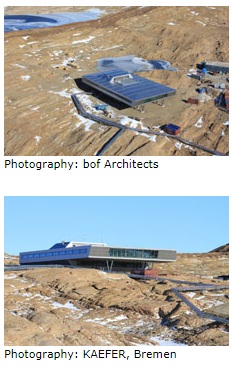
High performance aluminium glazing systems from Wicona are set to withstand some of the most extreme climatic conditions on earth, following the completion of a new research station in the Antarctic.
Designed by Hamburg-based architects, bof Architekten, the new Indian research station Bharati on the Antarctic coast comprises 134 prefabricated units wrapped in an aluminium envelope, which will withstand powerful winds of up to 270km/h, abnormally high thermal and mechanical loads caused by blizzards, huge quantities of snow, and temperatures of minus 40°C and below.
The 6,500sqft facility incorporates extensive glazing from Wicona which will allow the building’s occupants to maintain a strong visual connection with the dramatic surrounding landscape.
The specially-adapted WICTEC 50 ‘stick’ curtain walling system features triple glazing and highly insulated aluminium panels to ensure a comfortable internal environment and achieve an outstanding U value of 0.8 W/m2K. The glazed façade is inclined up to 15° at the two narrow ends and had to allow for assembly and disassembly for testing purposes in Germany before the final installation in the Antarctic.
By incorporating a high level of glazing into the station’s design, the 25 staff working there now have a magnificent view of their polar location, which will help to counter their sense of confinement. 15 scientists and logistics staff will live and work in the station all year round, carrying out oceanographic research into the 120 million year history into the break up of the Indian subcontinent.
Because of the extreme climatic conditions, the aluminium curtain walling profiles were fitted with electric heating elements, and the frame was pre-assembled into modules to speed up installation on site.
Fire protection was also a key design consideration for the building, resulting in the specification of Wicona’s fire-rated WICSTYLE heavy duty doors and WICLINE highly insulated windows.
The Bharati Research Station successfully illustrates how standardised façade systems can be specially adapted to meet the most stringent performance requirements and combined with innovative technological solutions to create an exceptional building.
The station’s structural core of prefabricated stacked units is enclosed by a steel sub-structure and an aluminium panel façade, which have created a double skin. The intermediate space between the outer envelope and the inner units provides an air cushion for regulating the inside temperature and to accommodate the building services, maintenance access and emergency exit.
The entire building had to be erected in a tight weather window of just three months during the Antarctic summer. Weighing around 1,000 tonnes, it was transported by ship from Antwerp to Cape Town where a further 50 modules were taken on board to make up the construction camp. The 5,200km journey by sea to the site in the Larsemann Hills on the north edge of the Antarctic was then completed.
Bharati is India’s third research base in Antarctica. It is a two-storey structure, raised on stilts and is designed to have a life span of 25 years, as well as to minimise any impact on the environment. It uses combined heat and power from renewable sources for heating, low sulphur fossil fuel, efficient treatment of effluent, and all hazardous and sanitary waste will be transported back to the mainland for disposal.
The team based at Bharati is undertaking cutting edge multi-disciplinary research and observation studies, including the movement of platonic plates, microbes surviving in the atmosphere and meteorological sciences.
Wicona offers a range of technically advanced glazing solutions for complex and bespoke aluminium façades. Its products include unitised and stick curtain walling, structural and roof glazing, highly insulated window systems and heavy duty doors.